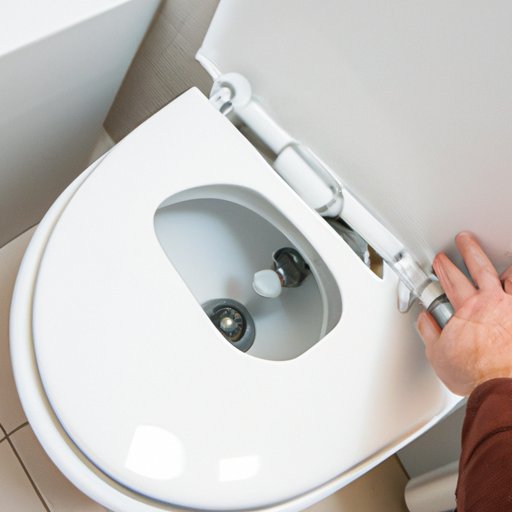Introduction
Toilets are plumbing fixtures that are used for the disposal of human waste. They are typically found in residential bathrooms and commercial restrooms and operate using gravity, pressure, and suction. In this article, we’ll explore the basics of how does a toilet work, provide an overview of toilet functionality and common components, explain how to troubleshoot common toilet problems, and guide you through toilet maintenance processes. We’ll also explore different types of toilets, the benefits of upgrading your toilet, and an analysis of toilet water usage.

Explaining the Science Behind Toilet Functionality
Toilets use a combination of gravity, pressure, and suction to function properly. Gravity is used to move the waste from the bowl into the trap. Pressure is used to push the waste through the pipes, while suction is used to create a vacuum in the trap which helps keep the smell of the waste contained. There are several components of a toilet that work together to ensure it functions properly.
How Does a Toilet Work?
When the flush lever is pressed, a chain or handle pulls up on the flapper valve at the bottom of the tank. This releases water from the tank into the bowl and creates a siphon effect. The siphon action pulls the waste down the drain and out of the bowl. As the water flows into the bowl, it pushes air ahead of it, creating a vacuum in the trap. This vacuum prevents sewer gas from entering the room.
Common Components of Toilets
The main components of a toilet include the tank, the bowl, the flapper valve, and the trap. The tank is located behind the toilet and stores the water used for flushing. The bowl is the part of the toilet that you sit on and contains the waste. The flapper valve is located at the bottom of the tank and seals off the water until the flush lever is pressed. The trap is the curved pipe that connects the bowl to the drainpipe and also serves as a barrier to prevent sewer gases from entering the room.
How to Troubleshoot Common Toilet Problems
Toilets can sometimes experience problems such as clogs, leaks, and inefficient flushing. Clogged toilets are often caused by too much toilet paper being flushed down the drain. Leaking toilets are usually caused by worn-out parts or a faulty seal between the tank and the bowl. Inefficient flushing can be caused by a variety of issues including a weak flapper valve, a tank that is not full enough, or a clog in the drainpipe.
A Guide to Toilet Maintenance
Regular cleaning and maintenance is important to keep your toilet in good working order. Cleaning the bowl and tank regularly will help keep your toilet free from debris and bacteria. You should also check the flapper valve and other parts for signs of wear and tear and replace or repair them as necessary. Additionally, you should check the water level in the tank and adjust it as needed.

Exploring Different Types of Toilets
There are a variety of different types of toilets available on the market today. Low-flush toilets use less water per flush than traditional toilets and are more efficient. Pressure-assisted toilets use compressed air to force the water out of the bowl more powerfully. Dual flush toilets have two buttons, one for a light flush and one for a deep flush, allowing you to use less water for smaller waste deposits.
The Benefits of Upgrading Your Toilet
Upgrading your toilet can provide many benefits including improved efficiency, increased comfort, and reduced water usage. Newer models are designed to be more efficient and use less water per flush. They are also designed to be more comfortable with features such as softer seats and heated water. Additionally, low-flush and dual flush toilets can help reduce your water usage.

An Overview of Toilet Installation Processes
Installing a toilet is a relatively straightforward process but there are a few things to consider. If you’re handy, you may want to attempt a DIY installation. However, if you’re not comfortable tackling the job yourself, it’s best to hire a professional plumber. Regardless of who does the installation, make sure to follow all local codes and regulations.

An Analysis of Toilet Water Usage
Toilets account for a large portion of a home’s water usage. To calculate your toilet’s water usage, you’ll need to know the gallon capacity of your toilet. You can then divide that number by the number of times you flush the toilet per day. To reduce water usage, you can try installing a low-flow toilet or a dual flush toilet. Additionally, you can limit the amount of toilet paper used per flush and avoid flushing items such as paper towels or feminine hygiene products.
Conclusion
Toilets are an essential part of any home or business. Understanding how they work and how to maintain them can help ensure they continue to function properly. From understanding the science behind toilet functionality to exploring different types of toilets and analyzing water usage, this article has provided a comprehensive guide to understanding toilet functionality and maintenance.
(Note: Is this article not meeting your expectations? Do you have knowledge or insights to share? Unlock new opportunities and expand your reach by joining our authors team. Click Registration to join us and share your expertise with our readers.)
